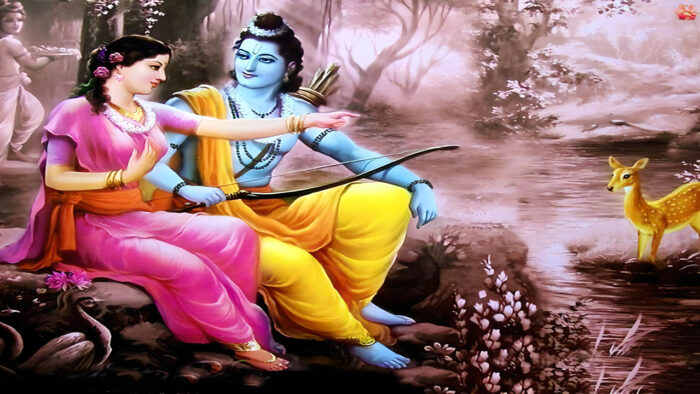The Ramayana, an epic that has been familiar to most of us since childhood, prominently showcases Lord Rama’s virtues such as his unwavering adherence to dharma, valor, righteousness, compassion, and more. This article delves into the persona of Rama, the heroic figure, whose deep love for his cherished wife Sita serves as a testimony to his character. Maharishi Valmiki’s Ramayana presents numerous instances of Rama’s deep affection for Sita, and his commitment to the eka-patni-vrata (the vow of having only one wife) stands as a vivid demonstration of his immense love for her.
Often, we talk about Sita, who is foremost among chaste women, with her unwavering devotion towards her husband Rama. While Sita undoubtedly exemplifies the ideal wife and her boundless love for Rama is widely known, we seldom encounter or discuss incidents that explicitly portray Rama’s love for Sita.
Apart from Maharishi Valmiki, other esteemed poets such as MahakaviKalidasa, Bhoja, and BhavabHutiH have also penned versions of the Ramayana. Within these poetic renditions, they have skillfully woven verses to beautifully illuminate the mutual love shared between Rama and Sita. Furthermore, in the 13th century, the renowned poet, philosopher and a great Srivaishnava Acharya (also called KavitharkikaSimha) Swami Vedanta Desika, took this concept to new heights by composing ‘HamsaSandesha’, a dhuta kavya. This work portrays Rama sending a hamsa (swan) as a messenger to his beloved Sita, aiming to console her and provide news of his impending arrival.
This article focuses on verses from Raghuvamsham, composed by the celebrated MahakaviKalidasa. Even those unfamiliar with Sanskrit literature have likely heard of MahakaviKalidasa and his magnum opus, Raghuvamsham, a classical poem that details the lineage of the Raghu dynasty. MahakaviKalidasa, following in the footsteps of Adikavi Valmiki, has portrayed Rama’s affection for Sita through poetry.
In Sanskrit literature, there are five Mahakavyas, the first being Raghuvamsham written by MahakaviKalidasa. A Mahakavyam is structured into several cantos, adhering to the rules of classical poetry. Raghuvamsha consists of 19 chapters. In the 13th chapter, Lord Rama, accompanied by Sita, returns to Ayodhya from Lanka in the pushpaka vimana, after defeating Ravana. While traveling in the pushpaka vimana, Rama points out various places to Sita, describing how he searched for her and the immense longing he felt during her abduction.
Here is a padyam from this chapter that beautifully portrays Rama’s love for Sita and his viraha-vedana (the pain of separation), showcasing the brilliance of Kalidasa.
सैषा स्थली यत्र विचिन्चता त्वां भ्रष्टं मया नूपुरमेकमुर्व्याम् ।
अदृश्यत त्वच्चरणारविन्दविश्लेषदुःखादिव बद्धमौनम् ।।
saiṣāsthalī yatra vicincatātvāṃbhraṣṭaṃmayānūpuramekamurvyām।
adṛśyatatvaccaraṇāravindaviśleṣaduḥkhādivabaddhamaunam।।
(“At this very place, while I was searching for you, I found your anklet alone, fallen and displaced. It seemed as if the anklet, in deep distress over losing the company of your lotus feet, chose to remain silent”)
We are all acquainted with the adage ‘UpamāKālidāsasya,’ which signifies that Kalidasa is celebrated as the master of similes. However, within this padyam, we can witness the exquisite utilization of ‘utpreksha-alankaraH’ (metaphorical expression), a figure of speech that enhances the beauty of the verse. Utpreksha involves presenting a factual element with poetic fancy or imaginative flair to create a dramatic effect. For example, when Rama discovers Sita’s anklet, the poet employs his creative imagination to speculate about the anklet’s silence instead of providing information about Sita to aid Rama. The fact is that an inanimate object like an anklet cannot converse, yet Kalidasa offers a reason for the anklet’s silence, thereby making the verse poetically beautiful.
While this aspect highlights the poetic brilliance of the verse, it also delves into the deeper meaning conveyed by the poet. Rama’s intense distress at the abduction of his beloved Sita is so overwhelming that, despite knowing that an inanimate object cannot converse, he tries to fathom why the anklet remained silent. He envisions a scenario where the anklet, much like himself, is in a state of shock due to the separation from its possessor and is rendered unable to articulate. This poignant depiction truly captures the depth of misery that Rama experienced after Sita’s abduction.
The subsequent padyam continues to delve into Rama’s state after Sita’s abduction. As Rama and Sita traverse the Malyavata mountain, Rama directs Sita’s attention to it and conveys his emotions.
एतद्गिरेर्माल्यवतः पुरस्तादाविर्भवत्यम्बरलेखि शृङ्गम् ।
नवं पयो यत्र घनैर्मया च त्वद्विपयोगाश्रु समं विसृष्टम् ।।
etadgirermālyavataḥpurastādāvirbhavatyambaralekhiśṛṅgam।
navaṃpayo yatra ghanairmayā ca tvadvipayogāśrusamaṃvisṛṣṭam।।
(There stands the Malyavata mountain, its peaks reaching the sky, where both raindrops and my tears fell in unison at the loss of you!)
In this instance, Rama conveys to Sita that he wept while thinking of her, and the Malyavata mountain serves as evidence of his emotions. It is as though the mountain cannot bear witness to Rama’s distress and therefore releases water in the form of rain. The mountain’s response to Rama’s anguish is depicted symbolically through the release of raindrops.
The profound and tender expressions of love shared between Rama and Sita in these verses vividly underscore the joyful and harmonious life they cherished before the unfortunate abduction of Sita. The thirteenth sarga contains many other padyams that portray the deep mutual affection between Rama and Sita, providing extreme delight to the readers.
Another noteworthy aspect to consider is that these particular padyams are meticulously crafted in the Upajati-chandas (meter), known for its distinct rhythmic structure. Composing a verse within a specific meter requires adherence to a set number of syllables, and in the case of Upajati, it encompasses 44 syllables. What truly magnifies the brilliance of these padyams is their ability to convey intricate meanings with remarkable clarity and depth despite the limitation of syllables.
In the verses of Kalidasa’s Raghuvamsham, we find a profound portrayal of Rama’s unwavering affection for Sita, transcending time and space. Through the poet’s masterful use of language and metaphors, we are transported to a world where emotions flow like a river, and the pain of separation becomes palpable. Rama’s love for Sita remains an eternal symbol of devotion.
Feature Image Credit: pxfuel.com
Disclaimer: The opinions expressed in this article belong to the author. Indic Today is neither responsible nor liable for the accuracy, completeness, suitability, or validity of any information in the article.









